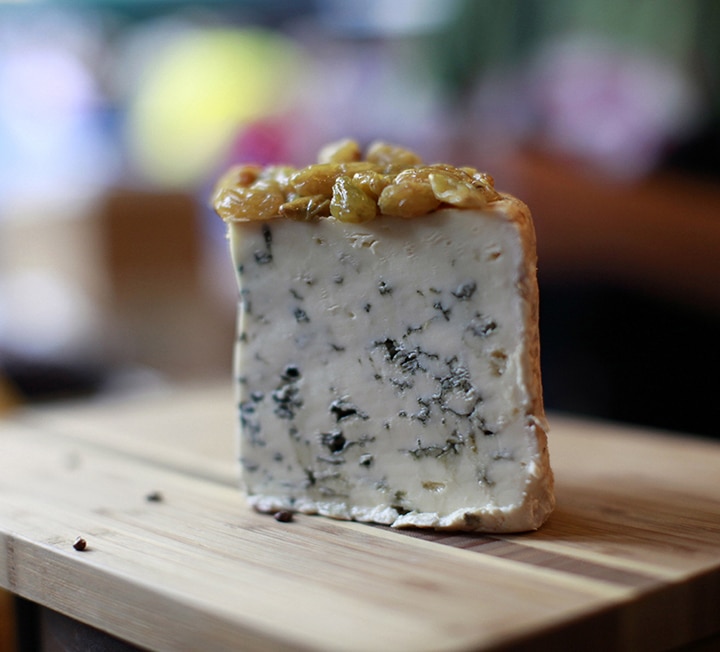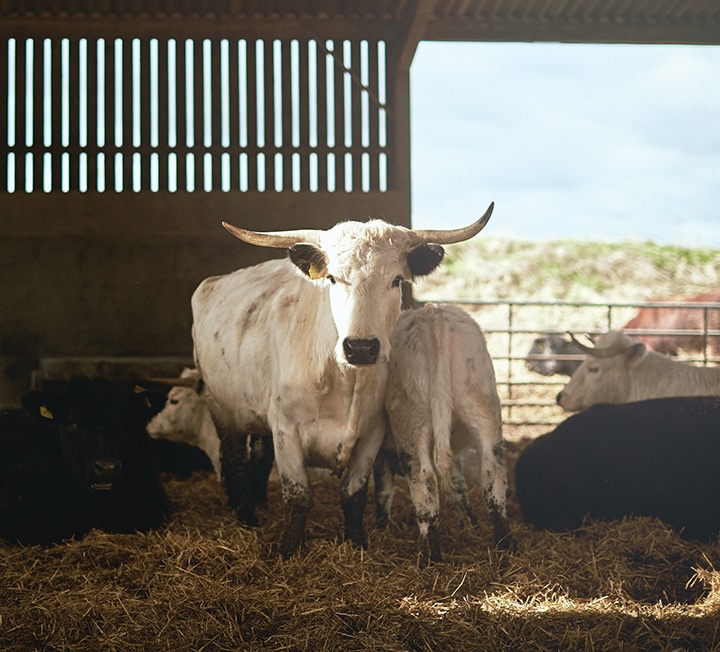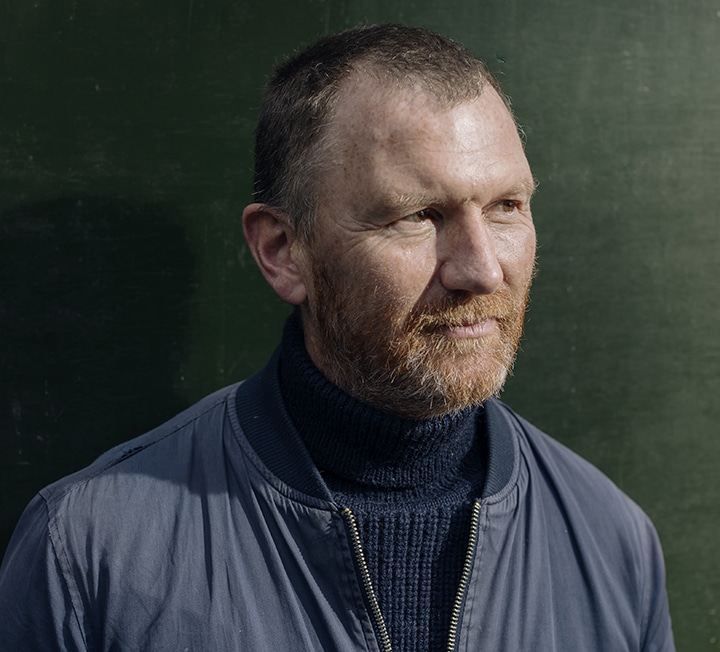Softly, softly
Clare Finney visits Park Farm, home of Bath Soft Cheese, to meet a man whose mission is to not only make beautiful cheese but to demystify the art by inviting the public in to watch
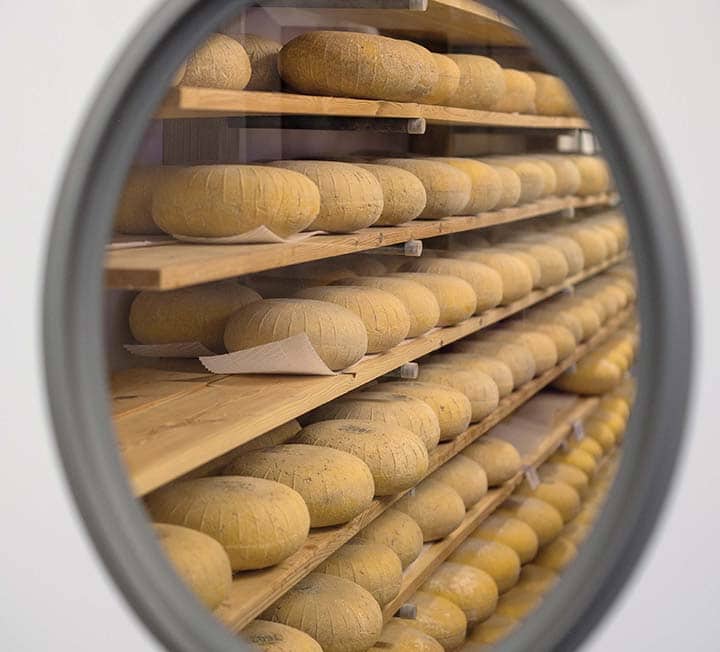

“THE ONLY PART OF THE ORIGINAL RECIPE WE DON’T FOLLOW IS THAT SALT BE SPRINKLED ON WITH THE AID OF A FEATHER”
Images: Orlando Gili
It is a depressing feature of our pre-sliced, pre-packaged age that seeing the process and the people behind food is for most of us a luxury rather than an everyday experience. While for my grandparents watching food being made was entirely unremarkable, today I count myself lucky to have seen lumbering cows wait patiently to be milked; to have felt the warm fug of a milking parlour; to have watched the freshest of milk tense and tighten into a lumpy soup of curds and whey.
My role is to share what I’ve experienced with readers who don’t have the time or the access that I do. It’s what I’m in Somerset for: to see the cows and the cheesemakers behind Bath Soft Cheese Co, and to write about them. But as soon as I arrive at Park Farm in Kelston, I discover that my role here has been slightly – but delightfully – overthrown.
“He’s been milking them about 10 minutes,” a small, ringleted girl tells me authoritatively as I enter a long room overlooking the milking parlour. Sat on the first row of seats with her face glued to the window, the child doesn’t even turn around as she declares the farm worker to have milked “about 20 cows so far” – a fact her equally transfixed mother confirms. They’ve been sat here since the start of milking, spellbound by the sight of milk pumping through pipes, the farmhand carefully washing each udder before attaching the suction cups, the cows chewing contentedly.
“Children love it. Adults love it!” remarks Hugh Padfield, the fourth-generation owner of Park Farm, as we tiptoe back out of his new public viewing gallery. The cafe in the adjacent building looks over the make room, “so the public can see the whole thing – the grass, the cows, the people, the cheese – there is nothing hidden.” If you’re in Bath, or are headed that way soon, then my work here is done. You just need to pay the Padfields a visit. If you’re not, then sit comfortably and I shall continue.
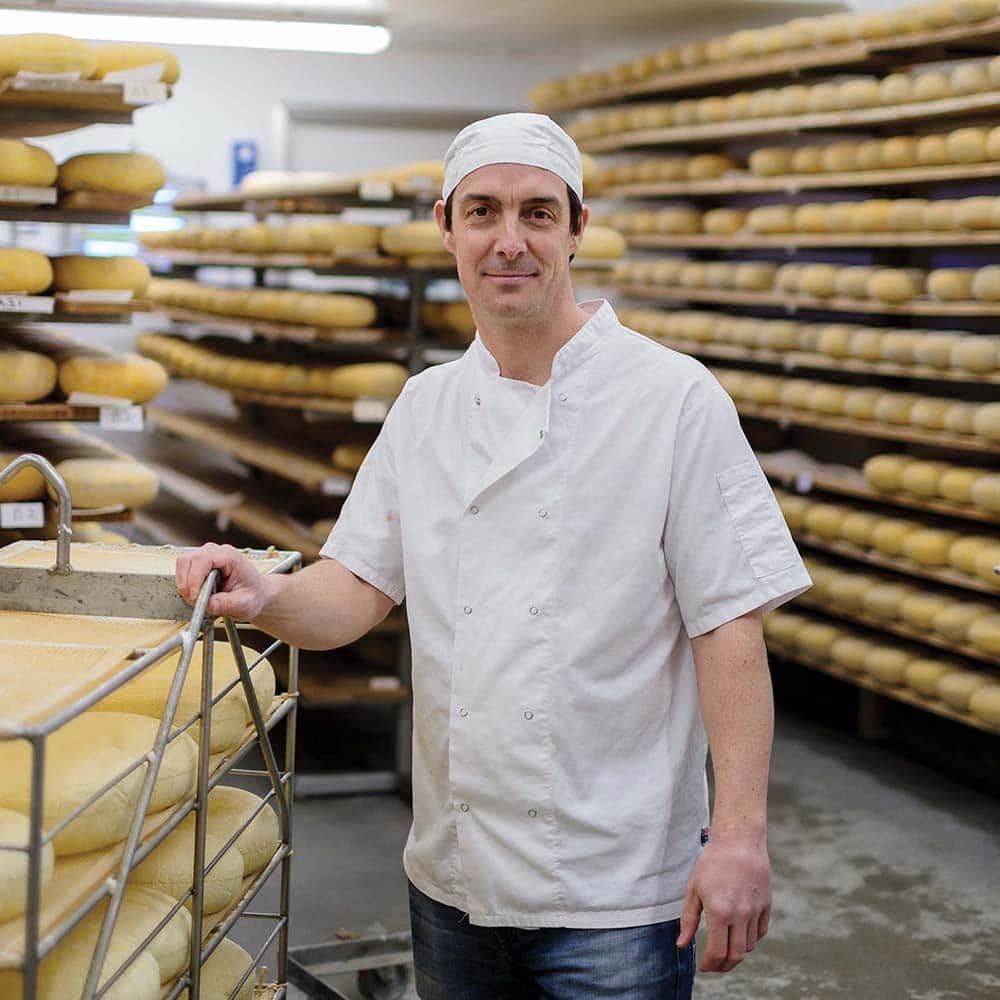
The story of Park Farm as Hugh knows it began with his great-grandparents, who moved to Kelston in 1914 and established a traditional mixed farm here in the foothills of the Cotswolds. “My great-grandmother made cheese, next to what is now my parents’ house.” Hugh points to a beautiful stone house, up a track, tucked away from the main farm buildings. In 1990, his father, Graham, decided to resurrect the family’s cheesemaking tradition, which along with most of British farmhouse cheese production, had been seen off after the second world war. “During the war, and for a long time afterwards, you would sell your milk to the Milk Marketing Board and buy it back if you wanted to make cheeses. Most was made into ‘government cheddar’,” Hugh explains.
Inspired to start making cheese, Graham Padfield did some research, and found a letter written by Horatio Nelson’s father to the legendary sailor recommending a cream cheese from Bath. Emboldened by further reports that suggested soft cheese was prevalent across the southwest of England prior to the 20th century, he tracked down a recipe in an old grocer’s book and set to making it. “The only part of the original recipe we don’t follow is that salt be sprinkled on the young cheeses ‘with the aid of a feather’,” Hugh smiles. “I’m not sure how well that would go down with the Environmental Health officers.”
Fast-forward 20 years and the Padfields have developed a whole family of cheeses, garnering numerous awards in the process. They’ve moved production to a purpose-built cheese dairy and milking parlour, having outgrown the old outhouse in which Hugh’s great-grandmother once worked, and they now have 160 heads of cattle to their name. The Padfields are proud to embrace technologies that can improve their practice. A few minutes after meeting him, Hugh leads me into the farm’s small office to find Graham energetically engaged in an online tractor auction. “The numbers go up so fast!” he murmurs. This is farming for the 21st century – and yet, outside the office, away from the viewing galleries, computers and sizzling cheese toastie machine, it really could be 1914 again.
The pastures are unchanged. The farmhouses are unchanged. “The fields are still named things like Station Ground and Cherry Cottage,” Hugh says proudly. A few years ago, he found a photograph of his father as a baby, held by his grandfather with his great-grandfather standing by: “It was in the yard outside our house – and the first thing I saw was that the plank of wood leaning against the wall in that photo is still there,” he laughs. “At least, there is still a plank of wood leaning against that wall. Over all these years people have clearly thought it the perfect place to leave a spare plank.”
It’s a touching detail, and oddly reassuring. Though the last 50 years has seen a shift from manual to automated milking, from wicker baskets to plastic cheese moulds, from informed guesswork to collars that measure the temperature, movement and milk yield of an animal, some things have remained constant. The cheese at Park Farm is still made by hand; the cows are still pasture-fed for at least six months of the year; and if you have a plank of wood going spare, there is a handy place for you to leave it, just against that wall.

For all the social media and viewing galleries, tradition clearly matters to Hugh. It’s one of the reasons he farms organically. “I think one of the fun things about being organic is learning how to work with nature. We fix nitrogen in the soil by encouraging the growth of clover, we manage that growth so there isn’t so much clover as to upset the cows’ stomachs; we take non-chemical approaches to tackling weeds.” They use muck to fertilise the field rather than artificial fertiliser, and the cows receive medicine only when it’s really needed – they aren’t routinely dosed, as they might be in an intensive system. Welfare standards are high – 600 acres to graze, and fresh bedding to come home to after a day spent enjoying the pasture.
In short, conditions at Park Farm are ripe for the creation of farmhouse cheeses – and that’s before you get to the geographical advantages of southwest England. I experience these first-hand when I arrive: vertical rain followed by warm, glistening sunshine illuminating grass of a brilliant, rich shade of green. “The climate and landscape here are much the same as in northern France, where camembert and brie originate,” says Hugh. “There’s a wet climate, low, lush grasslands and strong traditions of dairy and cider.” Camembert and the soft cheeses made in these parts seem to have originated at about the same time, “around the 1790s”, Hugh explains, and a degree of copying between the two regions seems probable. “The type of cheese and the type of cider they make in northern France – the soft, fizzy type – are similar to that made here. In many respects Brittany, Île-de-France and Normandy have more in common with southwest England than they do Paris or Provence.”
Like many farmers in Somerset, Graham Padfield brews his own cider, using organic apples harvested at Park Farm every autumn. It’s this cider that washes the Merry Wyfe cheeses every day for four weeks, lending them their distinctive, pinky-orange rind. Entering the maturing rooms is like walking into a sunset, with scores of round cheeses in various states of blushing maturation. “I love the colour palette – and the smell,” breathes Hugh. “That’s the smell of the bacteria turning the cheese orange. The cider provides the nutrients that it grows on.” The taste is not nearly as strong as the pungent cider smell suggests. It is creamy and tangy, more sweet than vegetal. It’s no Wyfe of Bath – my personal favourite, which is brined then aged in a maturing room the size of a small church – but there’s no denying its superiority as a washed-rind cheese.
Park Farm’s cheesemaking rooms are much like the rest of the farm: homespun but high tech, relaxed but orderly. In one, three cheesemakers are sealing some Bath Blues with a warm palette knife – a technique that looks not unlike icing a cake. “The blue mould peaks after seven weeks, but the cheese itself will peak after 12 weeks, so you need to give the cheese a five-week head-start,” Hugh explains. “They’re sealing it to keep the air out.” After five weeks, the cheesemakers will stab each cheese with a pin 200 times, to allow the bacteria to ‘breathe’ and unfurl its blue-veined fingers along the cracks. That must be therapeutic, I suggest to the cheesemakers. “It is for the first five minutes. The next four hours – not so much,” one of the group grins.
Popular belief would have it that unpasteurised milk always makes for better cheese. The Padfields beg to differ – and you don’t need to take their word for it. In 2015 their Bath Blue cheese won Supreme Cheese at the World Cheese Awards, the highest possible accolade for any cheese. Neither this nor any of the other cheeses produced at Park Farm is made with raw milk – the milk here has to be pasteurised, as this is such a badger-intensive area. “The risks of TB are too high,” says Hugh, and they aren’t taking any chances.

That they still manage to create highly characterful cheeses stems in part from their technique of batch-pasteurising at a lower temperature than usual, which “slightly caramelises the milk sugars,” says Hugh. “It’s gentler on the milk than flash pasteurisation, which heats the milk to a much higher temperature for a shorter time. Our way, you get more homemade, creamy flavours.” The result is delicious – rich, buttery, almost clotted cream-like. The starters they use are also designed to mitigate the loss of the milk’s naturally-occurring bacteria. “One of the things I am keen to point out is how carefully we select the cultures we inoculate our cheese with, some of which replicate the bacteria you’d find in raw milk. This gives it so much flavour.”
The Padfields use calf-based rennet to coagulate the milk in all but two of their cheeses, in recognition of the ancient origins of cheesemaking (“It is up there with berries and meat as one of our earliest food sources”), and the fact that the beef industry and the dairy industry are unavoidably linked. “Farmers know that the dairy industry could not exist without the beef industry. Cows have calves, half of those are boys, those boys go to become beef.” The use of rennet is, he says, a natural part of that cycle, and it tastes better. “All rennets have a slight tendency towards bitterness, but vegetarian rennet is particularly bitter,” Hugh continues. “I know farmers who use vegetarian rennet when they supply supermarkets, but use traditional rennet when entering their cheese into awards.” That said, the subtle sweetness of Wyfe of Bath and Merry Wyfe is enough to mask the bitterness of vegetarian rennet, enabling Bath Soft Cheese to cater to vegetarians to some degree.
Once set, the curds are stirred or cut to release the whey and achieve the desired consistency and texture. To retain moisture, soft cheese needs larger curds; to lose moisture, hard cheese demands smaller ones. The size of these, and the point at which the mixture is poured into moulds is down to the cheesemaker, who will make a judgement call according to the look and feel of the curds and the type of cheese they’re making. “The skill of the cheesemaker is vital,” says Hugh. There is no probe or gauge to match it. It is experience and observation that enables him to say when the mixtures have sufficiently coagulated.
Watching them in action (they’re making Bath Soft Cheese when I’m there, and the curds and whey slop gently against the side of the buckets as they stir) is more mesmeric than mechanical, despite the incredible level of precision the process needs. In the maturing rooms, cheeses are stacked, turned, brushed or washed by hand, and sit on wooden shelves which propagate and sustain the friendly yeast cultures that live on the rinds.
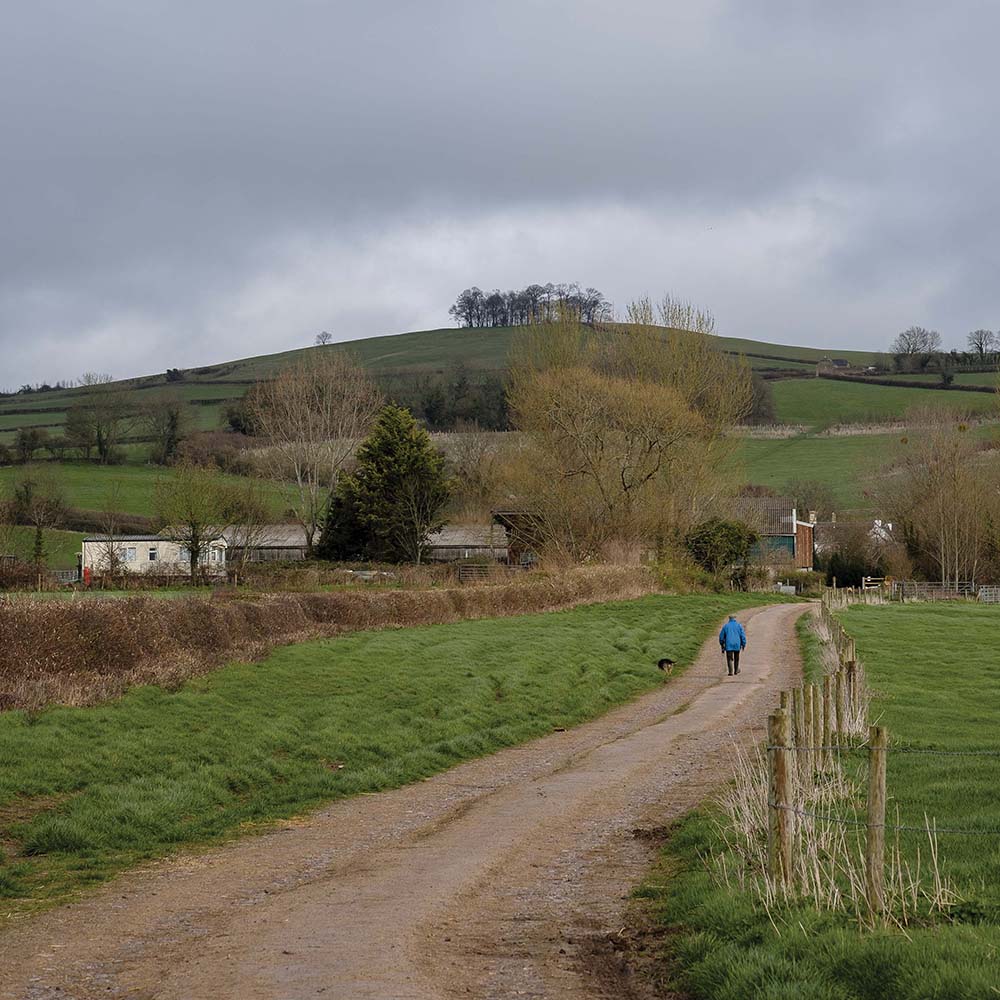
The silence is palpable. You can almost hear the bacteria: fermenting, growing, spreading, uniting milk, time and provenance. “There are billions of bacteria here in each cheese. They are living things,” says Hugh, proudly. In the maturation rooms he breaks an immature Bath Soft Cheese in half, and shares some with me. “As a young cheese it is salty, a bit creamy, but chalkier,” he muses as he chews. Later on, we have a cheeseboard in the cafe and taste the same cheese again, several weeks older. “Now there are notes of slow-cooked mushrooms, bright lemons and garlic. It’s so different,” he exclaims. Ripe, rich and squidgy, it cries out for sourdough, which the cafe provides with characteristic generosity.
On the table next to us, another family have sat down to watch the cheesemakers. “There’s something about understanding from an early age just where your food comes from. Humans don’t like surprises,” says Hugh. Part of the vehemence of movements like extreme veganism comes from a feeling of being “duped”, he continues – “the sense of the food industry keeping things from us. That’s why we’ve been so keen on people visiting.” Tomorrow, Hugh will take a group of primary school children around the farm – something he’s been doing increasingly since he found his son’s school’s ‘field to fork’ trip entailed going to their local supermarket. He’s still not worked out how to answer the “where do calves come from” question – “I think I’ll leave that one for the teachers or parents!” he grins – but he doesn’t shy away from the kids’ other queries. “We want people to challenge us. We want people to ask questions. We want people to come and see.”
